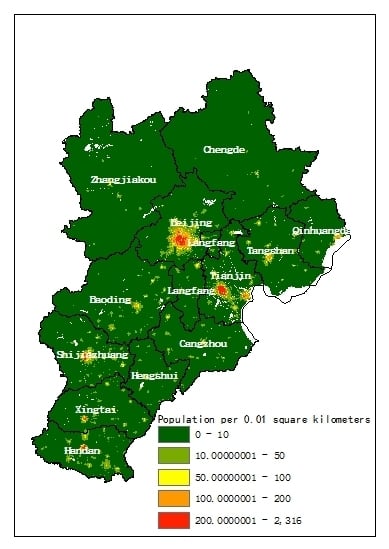Improving the Accuracy of Fine-Grained Population Mapping Using Population-Sensitive POIs
Abstract
1. Introduction
2. Experimental Area and Data
2.1. Experimental Area
2.2. Data and Preprocessing
2.2.1. Demographic Data
2.2.2. Geospatial Big Data
2.2.3. Remotely Sensed Products
2.2.4. Datasets for Accuracy Comparison
3. Methods
3.1. Identification of Population-Sensitive POI Categories
3.2. Population-Sensitive POI Driven Dasymetric Model
3.3. Accuracy Assessment and Comparison with Other Population Datasets
4. Results and Analysis
4.1. Population-Sensitive POI Categories
4.2. Population Map from the PSP-Driven Model
4.3. Accuracy Assessment
5. Conclusions and Discussion
Author Contributions
Funding
Acknowledgments
Conflicts of Interest
References
- Bakillah, M.; Liang, S.; Mobasheri, A.; Arsanjani, J.J.; Zipf, A. Fine-resolution population mapping using OpenStreetMap points-of-interest. Int. J. Geogr. Inf. Sci. 2014, 28, 1940–1963. [Google Scholar] [CrossRef]
- Jia, P.; Qiu, Y.; Gaughan, A.E. A fine-scale spatial population distribution on the high-resolution gridded population surface and application in Alachua County, Florida. Appl. Geogr. 2014, 50, 99–107. [Google Scholar] [CrossRef]
- Yao, Y.; Liu, X.; Li, X.; Zhang, J.; Zhaotang, L.; Mai, K.; Zhang, Y. Mapping fine-scale population distributions at the building level by integrating multisource geospatial big data. Int. J. Geogr. Inf. Sci. 2017, 31, 1220–1244. [Google Scholar] [CrossRef]
- Ahola, T.; Virrantaus, K.; Krisp, J.M.; Hunter, G.J. A spatio-temporal population model to support risk assessment and damage analysis for decision-making. Int. J. Geogr. Inf. Sci. 2007, 21, 935–953. [Google Scholar] [CrossRef]
- Dobson, J.E.; Bright, E.A.; Coleman, P.R.; Durfee, R.C.; Worley, B.A. LandScan: A global population database for estimating populations at risk. Photogramm. Eng. Remote Sens. 2000, 66, 849–857. [Google Scholar]
- Zeng, J.; Zhu, Z.Y.; Zhang, J.L.; Ouyang, T.P.; Qiu, S.F.; Zou, Y.; Zeng, T. Social vulnerability assessment of natural hazards on county-scale using high spatial resolution satellite imagery: A case study in the Luogang district of Guangzhou, South China. Environ. Earth Sci. 2012, 65, 173–182. [Google Scholar] [CrossRef]
- Aubrecht, C.; Ozceylan, D.; Steinnocher, K.; Freire, S. Multi-level geospatial modeling of human exposure patterns and vulnerability indicators. Nat. Hazards 2013, 68, 147–163. [Google Scholar] [CrossRef]
- Cutter, S.L.; Boruff, B.J.; Shirley, W.L. Social vulnerability to environmental hazards. Soc. Sci. Q. 2003, 84, 242–261. [Google Scholar] [CrossRef]
- Hay, S.I.; Noor, A.M.; Nelson, A.; Tatem, A.J. The accuracy of human population maps for public health application. Trop. Med. Int. Health 2005, 10, 1073–1086. [Google Scholar] [CrossRef]
- Jia, P.; Sankoh, O.; Tatem, A.J. Mapping the environmental and socioeconomic coverage of the INDEPTH international health and demographic surveillance system network. Health Place 2015, 36, 88–96. [Google Scholar] [CrossRef]
- Holt, J.B.; Lo, C.; Hodler, T.W. Dasymetric estimation of population density and areal interpolation of census data. Cartogr. Geogr. Inf. Sci. 2004, 31, 103–121. [Google Scholar] [CrossRef]
- Langford, M. Rapid facilitation of dasymetric-based population interpolation by means of raster pixel maps. Comput. Environ. Urban Syst. 2007, 31, 19–32. [Google Scholar] [CrossRef]
- Reibel, M.; Agrawal, A. Areal interpolation of population counts using pre-classified land cover data. Popul. Res. Policy Rev. 2007, 26, 619–633. [Google Scholar] [CrossRef]
- Lo, C. Population estimation using geographically weighted regression. GISci. Remote Sens. 2008, 45, 131–148. [Google Scholar] [CrossRef]
- Tobler, W.; Deichmann, U.; Gottsegen, J.; Maloy, K. World population in a grid of spherical quadrilaterals. Int. J. Popul. Geogr. 1997, 3, 203–225. [Google Scholar] [CrossRef]
- Wang, L.; Wang, S.; Zhou, Y.; Liu, W.; Hou, Y.; Zhu, J.; Wang, F. Mapping population density in China between 1990 and 2010 using remote sensing. Remote Sens. Environ. 2018, 210, 269–281. [Google Scholar] [CrossRef]
- Sorichetta, A.; Hornby, G.M.; Stevens, F.R.; Gaughan, A.E.; Linard, C.; Tatem, A.J. High-resolution gridded population datasets for Latin America and the Caribbean in 2010, 2015, and 2020. Sci. Data 2015, 2, 150045. [Google Scholar] [CrossRef]
- Stevens, F.R.; Gaughan, A.E.; Linard, C.; Tatem, A.J. Disaggregating census data for population mapping using random forests with remotely-sensed and ancillary data. PLoS ONE 2015, 10, e0107042. [Google Scholar] [CrossRef]
- Wardrop, N.A.; Jochem, W.C.; Bird, T.J.; Chamberlain, H.R.; Clarke, D.; Kerr, D.; Bengtsson, L.; Juran, S.; Seaman, V.; Tatem, A.J. Spatially disaggregated population estimates in the absence of national population and housing census data. Proc. Natl. Acad. Sci. USA 2018, 115, 3529–3537. [Google Scholar] [CrossRef]
- Balk, D.; Yetman, G. The Global Distribution of Population: Evaluating the Gains in Resolution Refinement; Center for International Earth Science Information Network (CIESIN), Columbia University: New York, NY, USA, 2004. [Google Scholar]
- Tobler, W.; Uwe, D.; Jone, G.; Kelly, M. The Global Demography Project (95-6); National Center for Geographic Information and Analysis Department of Geography: Santa Barbara, CA, USA, 1995. [Google Scholar]
- Eicher, C.L.; Brewer, C.A. Dasymetric mapping and areal interpolation: Implementation and evaluation. Cartogr. Geogr. Inf. Sci. 2001, 28, 125–138. [Google Scholar] [CrossRef]
- Mennis, J. Generating surface models of population using dasymetric mapping. Prof. Geogr. 2003, 55, 31–42. [Google Scholar]
- Mennis, J. Dasymetric mapping for estimating population in small areas. Geogr. Compass 2009, 3, 727–745. [Google Scholar] [CrossRef]
- Mennis, J.; Hultgren, T. Intelligent dasymetric mapping and its application to areal interpolation. Cartogr. Geogr. Inf. Sci. 2006, 33, 179–194. [Google Scholar] [CrossRef]
- Mrozinski, R.D.; Cromley, R.G. Singly-and doubly-constrained methods of areal interpolation for vector-based GIS. Trans. GIS 1999, 3, 285–301. [Google Scholar] [CrossRef]
- Nagle, N.N.; Buttenfield, B.P.; Leyk, S.; Spielman, S. Dasymetric modeling and uncertainty. Ann. Assoc. Am. Geogr. 2014, 104, 80–95. [Google Scholar] [CrossRef]
- Azar, D.; Engstrom, R.; Graesser, J.; Comenetz, J. Generation of fine-scale population layers using multi-resolution satellite imagery and geospatial data. Remote Sens. Environ. 2013, 130, 219–232. [Google Scholar] [CrossRef]
- Cai, J.; Huang, B.; Song, Y. Using multi-source geospatial big data to identify the structure of polycentric cities. Remote Sens. Environ. 2017, 202, 210–221. [Google Scholar] [CrossRef]
- Deville, P.; Linard, C.; Martin, S.; Gillbert, M.; Stevens, F.; Gaughan, A.; Blondel, V.; Tatem, A. Dynamic population mapping using mobile phone data. Proc. Natl. Acad. Sci. USA 2014, 111, 15888–15893. [Google Scholar] [CrossRef]
- Li, K.; Chen, Y.; Li, Y. The Random Forest-Based Method of Fine-Resolution Population Spatialization by Using the International Space Station Nighttime Photography and Social Sensing Data. Remote Sens. 2018, 10, 1650. [Google Scholar] [CrossRef]
- Li, X.; Zhou, W. Dasymetric mapping of urban population in China based on radiance corrected DMSP-OLS nighttime light and land cover data. Sci. Total Environ. 2018, 643, 1248–1256. [Google Scholar] [CrossRef]
- Yang, X.; Huang, Y.; Dong, P.; Jiang, D.; Liu, H. An Updating System for the Gridded Population Database of China Based on Remote Sensing, GIS and Spatial Database Technologies. Sensors 2009, 9, 1128–1140. [Google Scholar] [CrossRef] [PubMed]
- Yang, X.; Ye, T.; Zhao, N.; Chen, Q.; Yue, W.; Qi, J.; Zeng, B.; Jia, P. Population Mapping with Multisensor Remote Sensing Images and Point-Of-Interest Data. Remote Sens. 2019, 11, 574. [Google Scholar] [CrossRef]
- Zhang, Y.; Li, Q.; Wang, H.; Du, X.; Huang, H. Community scale livability evaluation integrating remote sensing, surface observation and geospatial big data. Int. J. Appl. Earth Obs. Geoinform. 2019, 80, 173–186. [Google Scholar] [CrossRef]
- Canavosio-Zuzelski, R.; Agouris, P.; Doucette, P. A photogrammetric approach for assessing positional accuracy of OpenStreetMap© roads. ISPRS Int. J. Geo-Inf. 2013, 2, 276–301. [Google Scholar] [CrossRef]
- Touya, G.; Antoniou, V.; Olteanu-Raimond, A.; Damme, M. Assessing crowdsourced POI quality: Combining methods based on reference data, history, and spatial relations. ISPRS Int. J. Geo-Inf. 2017, 6, 80. [Google Scholar] [CrossRef]
- Gao, S.; Janowicz, K.; Couclelis, H. Extracting urban functional regions from points of interest and human activities on location-based social networks. Trans. GIS 2017, 21, 446–467. [Google Scholar] [CrossRef]
- Hu, T.; Yang, J.; Li, X.; Gong, P. Mapping urban land use by using landsat images and open social data. Remote Sens. 2016, 8, 151. [Google Scholar] [CrossRef]
- Jiang, S.; Alves, A.; Rodrigues, F.; Ferreira, J.; Pereira, F. Mining point-of-interest data from social networks for urban land use classification and disaggregation. Comput. Environ. Urban Syst. 2015, 53, 36–46. [Google Scholar] [CrossRef]
- Liu, X.; He, J.; Yao, Y.; Zhang, J.; Liang, H.; Wang, H.; Hong, Y. Classifying urban land use by integrating remote sensing and social media data. Int. J. Geogr. Inf. Sci. 2017, 31, 1675–1696. [Google Scholar] [CrossRef]
- McKenzie, G.; Janowicz, K.; Gao, S.; Yang, J.; Hu, Y. POI pulse: A multi-granular, semantic signature–based information observatory for the interactive visualization of big geosocial data. Cartogr. Int. J. Geogr. Inf. Geovis. 2015, 50, 71–85. [Google Scholar] [CrossRef]
- Wang, Y.; Gu, Y.; Dou, M.; Qiao, M. Using spatial semantics and interactions to identify urban functional regions. ISPRS Int. J. Geo-Inf. 2018, 7, 130. [Google Scholar] [CrossRef]
- Yoshida, D.; Song, X.; Raghavan, V. Development of track log and point of interest management system using Free and Open Source Software. Appl. Geomat. 2010, 2, 123–135. [Google Scholar] [CrossRef]
- Zhang, Y.; Li, Q.; Huang, H.; Wu, W.; Du, X.; Wang, H. The combined use of remote sensing and social sensing data in fine-grained urban land use mapping: A case study in Beijing, China. Remote Sens. 2017, 9, 865. [Google Scholar] [CrossRef]
- Zhang, C.; Qiu, F. A point-based intelligent approach to areal interpolation. Prof. Geogr. 2011, 63, 262–276. [Google Scholar] [CrossRef]
- Ye, T.; Zhao, N.; Yang, X.; Ouyang, Z.; Liu, X.; Chen, Q.; Hu, K.; Yue, W.; Qi, J.; Li, Z.; et al. Improved population mapping for China using remotely sensed and points-of-interest data within a random forests model. Sci. Total Environ. 2019, 658, 936–946. [Google Scholar] [CrossRef]
- Sutton, P.; Sutton, D.; Elvidge, C.; Baugh, K. Census from Heaven: An estimate of the global human population using night-time satellite imagery. Int. J. Remote Sens. 2001, 22, 3061–3076. [Google Scholar] [CrossRef]
- Jordan, L. Applying Thiessen Polygon Catchment Areas and Gridded Population Weights to Estimate Conflict-Driven Population Changes in South Sudan. ISPRS Ann. Photogramm. Remote Sens. Spat. Inf. Sci. 2017, 4, 23. [Google Scholar] [CrossRef]
- Zvoleff, A.; Rosa, M.; Ahumada, J. Monitoring Population and Land Use Change in Tropical Forest Protected Areas. In Proceedings of the AGU Fall Meeting Abstracts, San Francisco, CA, USA, 15–19 December 2014. [Google Scholar]
- Zhang, C.; Zhang, C.; Luo, L.; Xu, W.; Ledwith, V. Use of local Moran’s I and GIS to identify pollution hotspots of Pb in urban soils of Galway, Ireland. Sci. Total Environ. 2008, 398, 212–221. [Google Scholar] [CrossRef]
- Li, W.; Li, W.; Xu, B.; Song, Q.; Liu, X.; XU, J.; Brookes, P. The identification of ‘hotspots’ of heavy metal pollution in soil–rice systems at a regional scale in eastern China. Sci. Total Environ. 2014, 472, 407–420. [Google Scholar] [CrossRef]
- Koperski, K.; Han, J. Discovery of Spatial Association Rules in Geographic Information Databases, in International Symposium on Spatial Databases; Springer: Burnaby, BC, Canada, 1995. [Google Scholar]
- Han, J.; Pei, J.; Yin, Y. Mining Frequent Patterns without Candidate Generation. ACM Sigmod Rec. 2000, 29, 1–12. [Google Scholar] [CrossRef]
- Hornik, K.; Grun, B.; Hahsler, M. Arules-A computational environment for mining association rules and frequent item sets. J. Stat. Softw. 2005, 14, 1–25. [Google Scholar]
- Breiman, L. Random forests. Mach. Learn. 2001, 45, 5–32. [Google Scholar] [CrossRef]
- Breiman, L. Bagging predictors. Mach. Learn. 1996, 24, 123–140. [Google Scholar] [CrossRef]
- Tibshirani, R. Bias, Variance and Prediction Error for Classification Rules; Citeseer, Department of Preventive Medicine and Biostatistics and Department of Statistics, University of Toronto: Toronto, ON, Canada, 1996. [Google Scholar]
- Wolpert, D.H.; Macready, W.G. An efficient method to estimate bagging’s generalization error. Mach. Learn. 1999, 35, 41–55. [Google Scholar] [CrossRef]
- R Core Team. R: A Language and Environment for Statistical Computing; R Foundation for Statistical Computing: Vienna, Austria, 2013. [Google Scholar]
- Liaw, A.; Wiener, M. Classification and regression by randomForest. R News 2002, 2, 18–22. [Google Scholar]
- Mocnik, F.-B.; Mobasheri, A.; GriesBaum, L.; Eckle, M.; Jacobs, C.; Klonner, C. A grounding-based ontology of data quality measures. J. Spat. Inf. Sci. 2018, 2018, 1–25. [Google Scholar] [CrossRef]
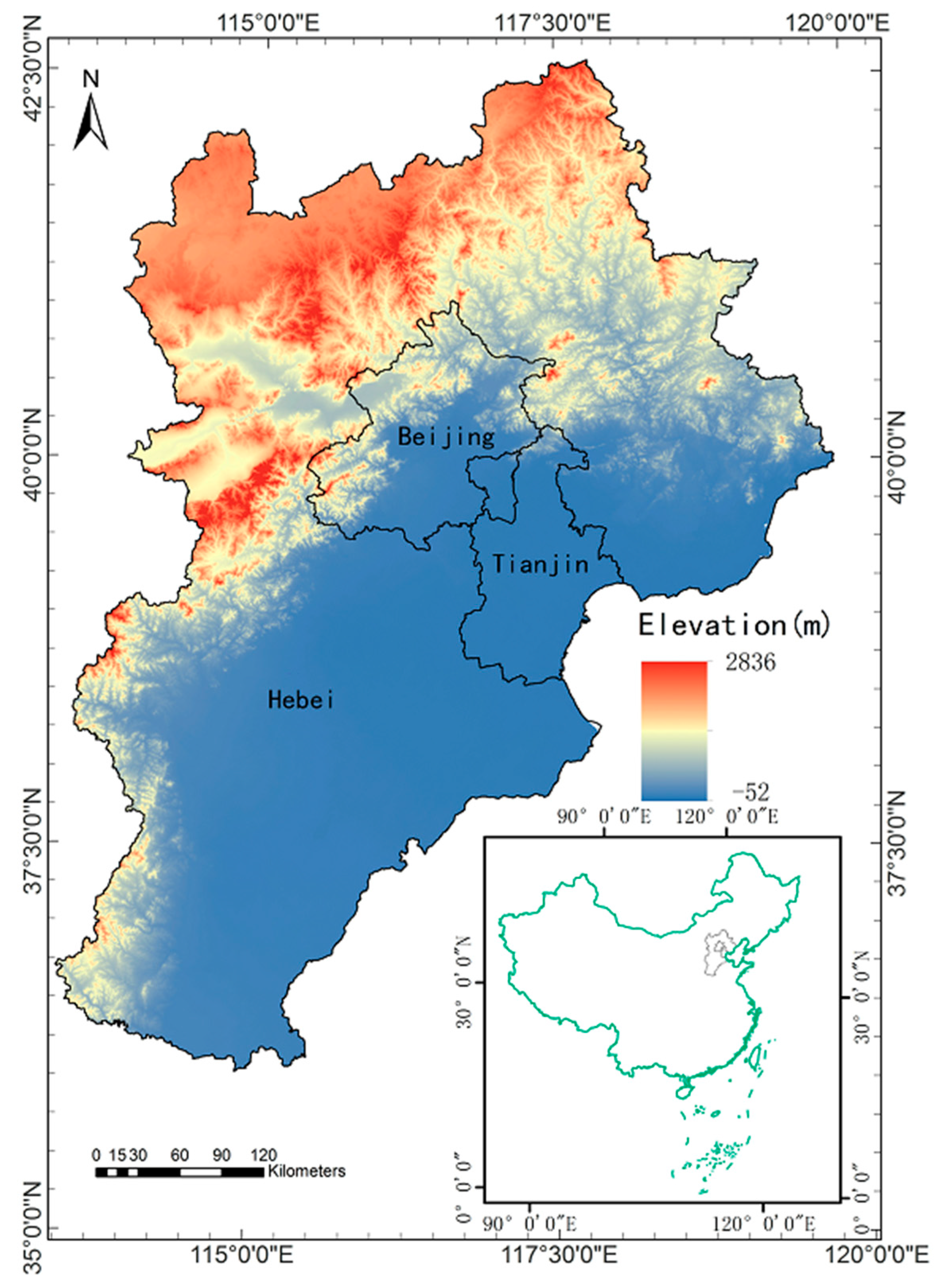
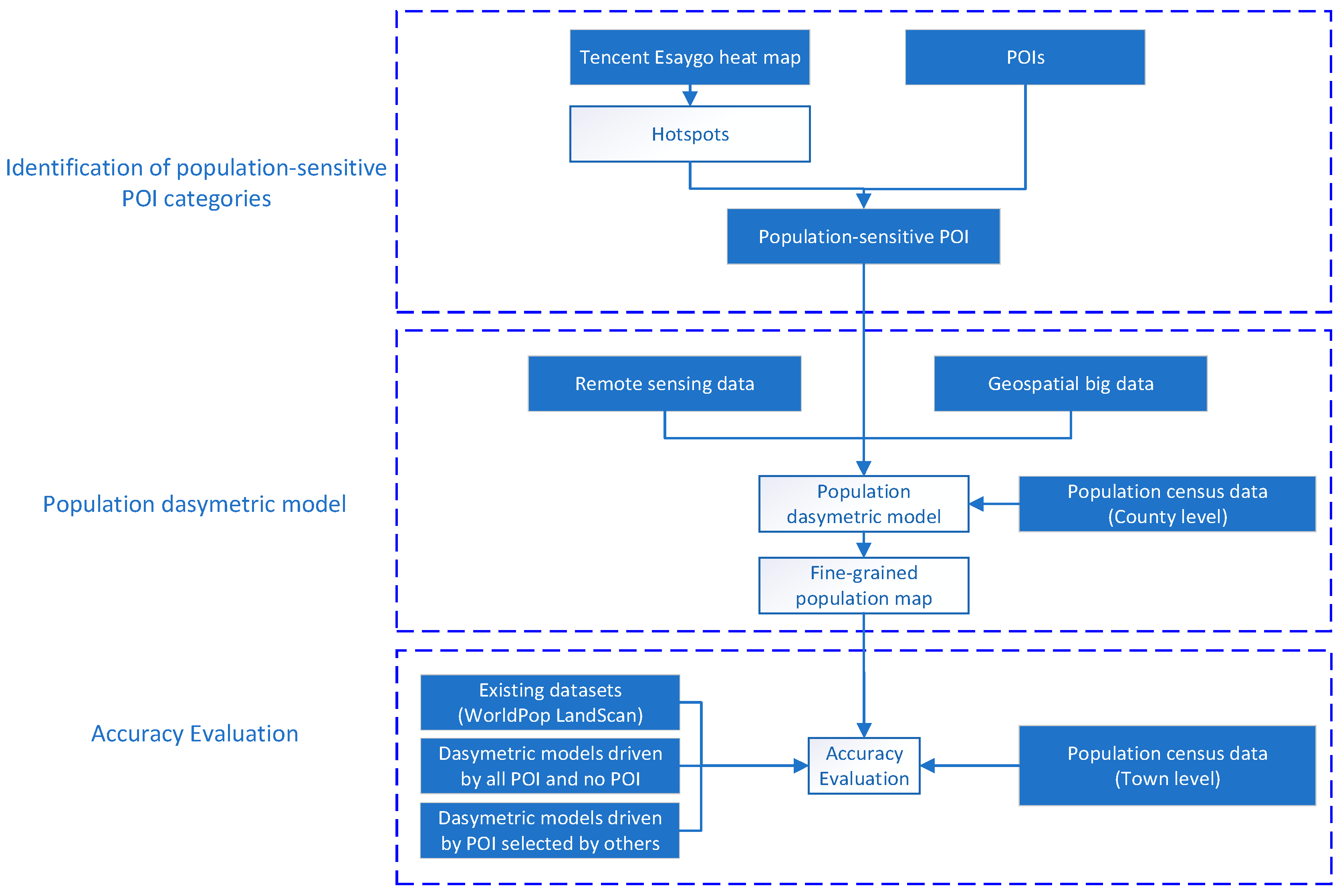


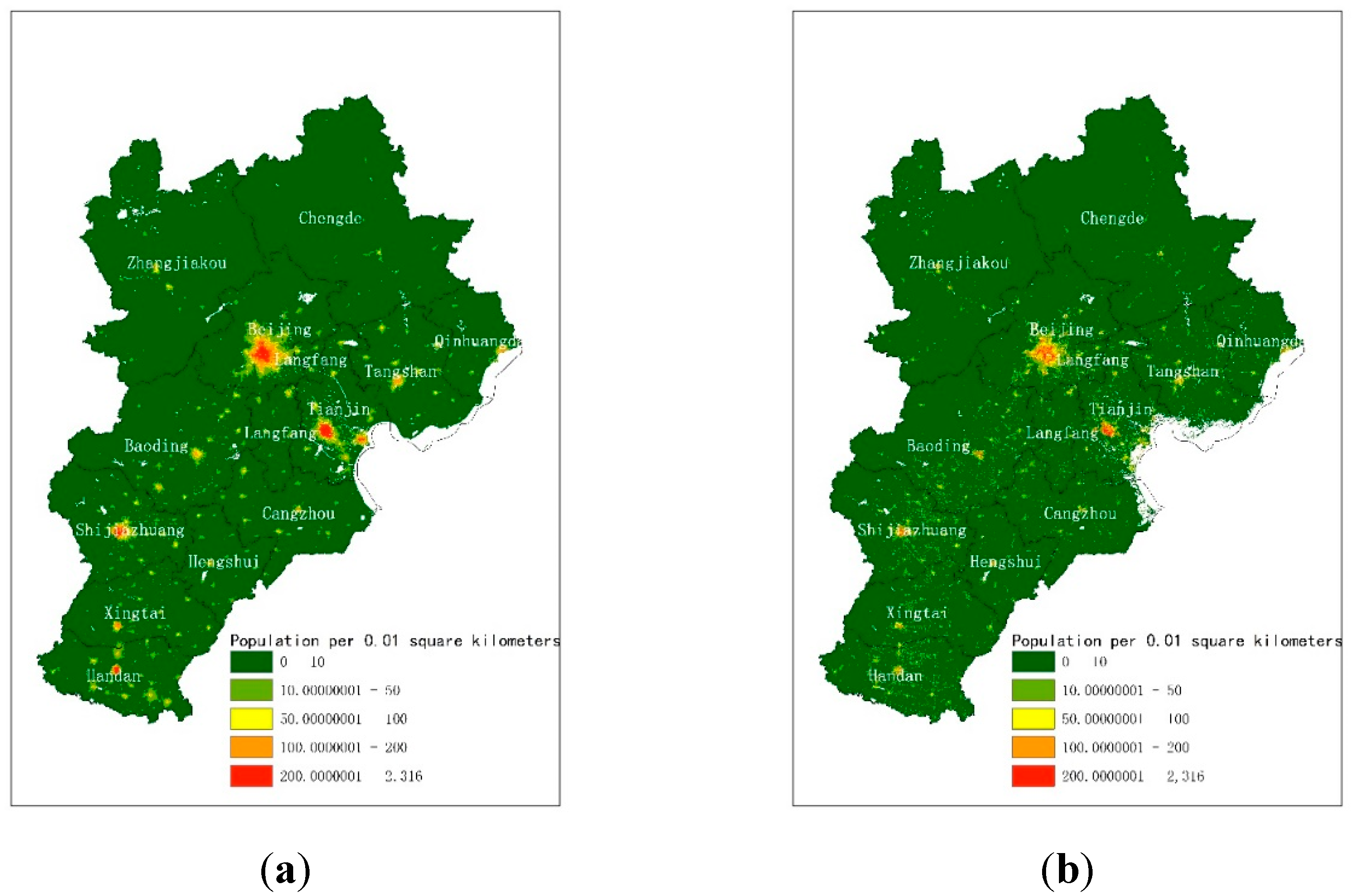
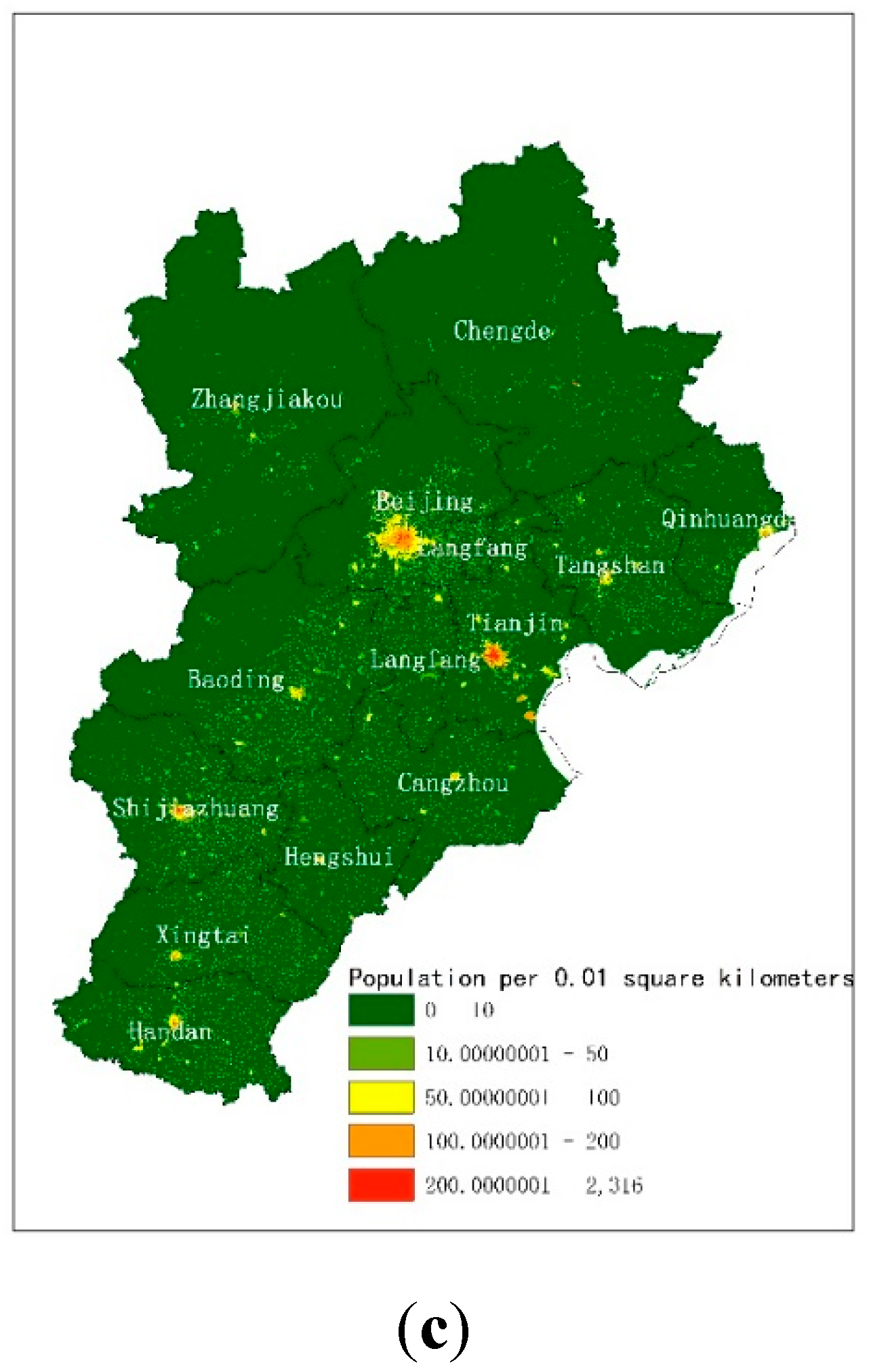
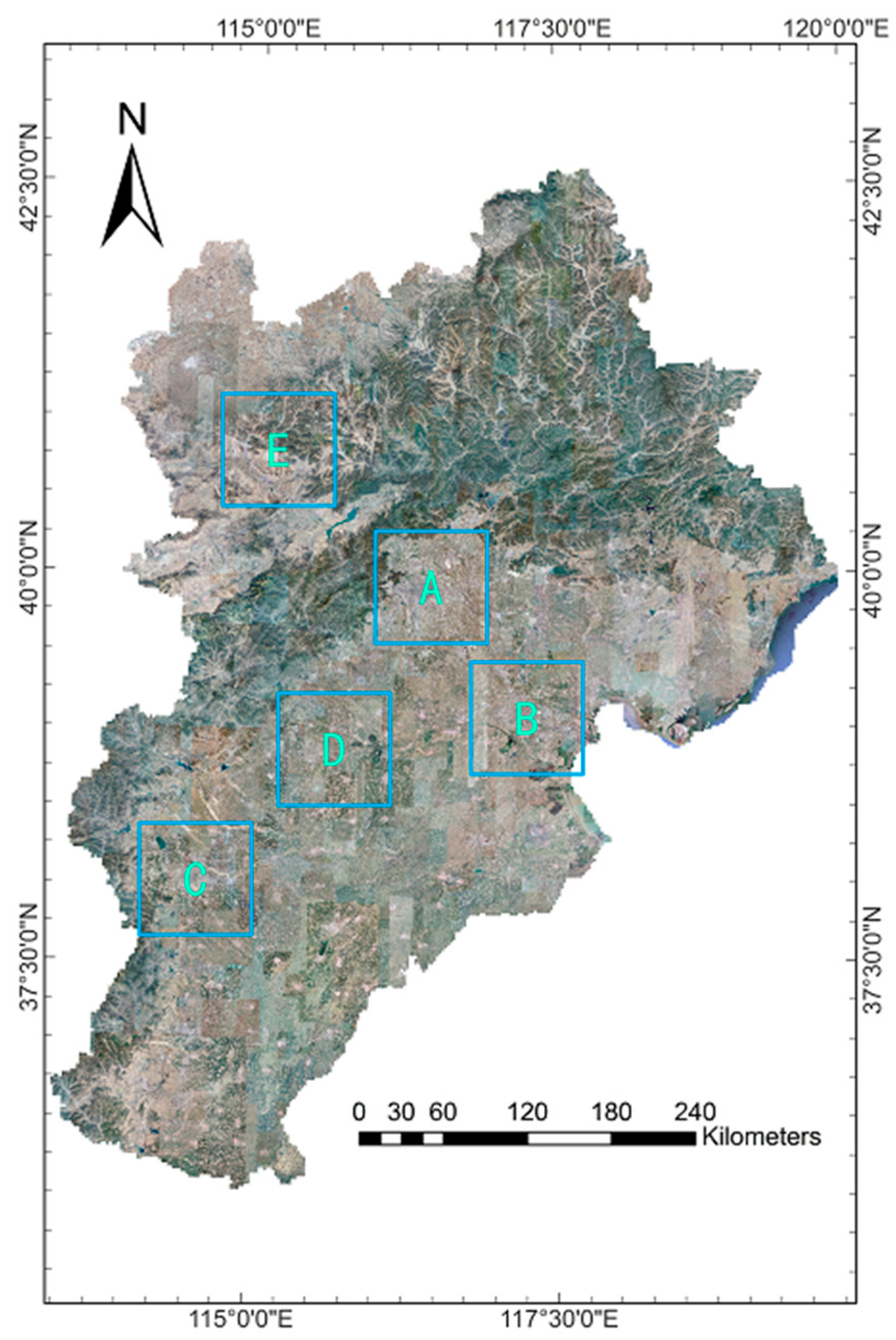
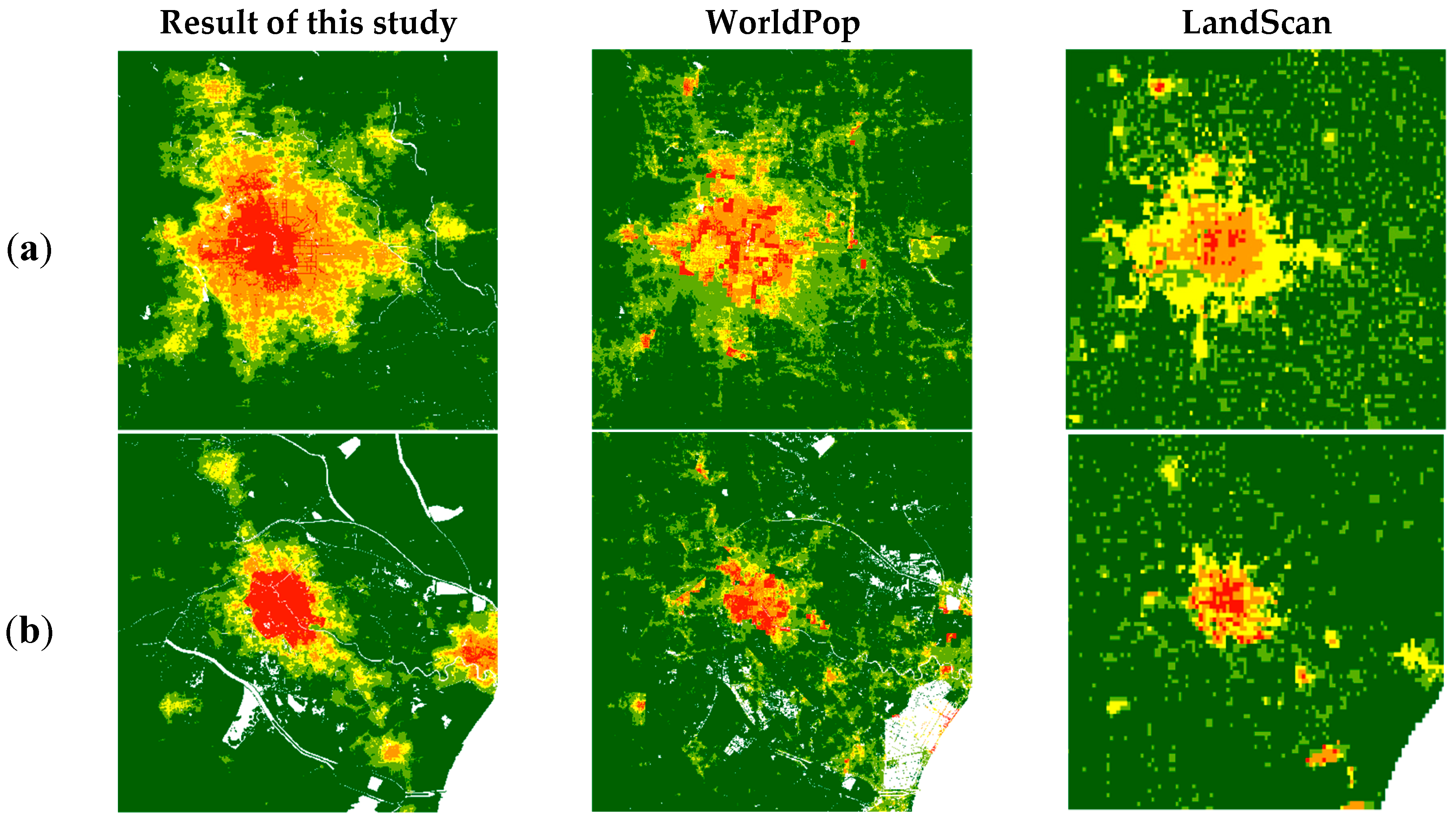

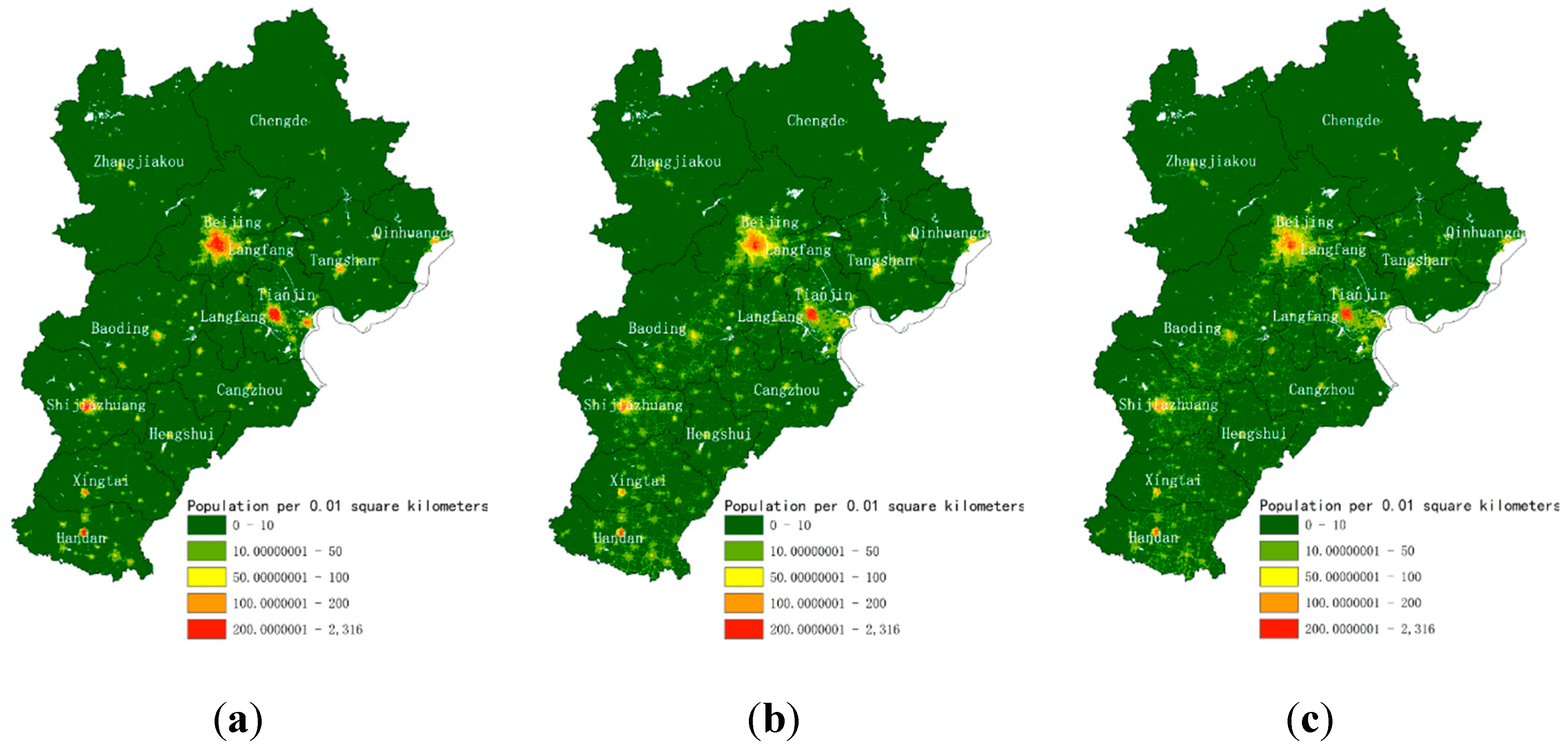




| Covariate | Dataset | Year | Source |
|---|---|---|---|
| Covariates for dasymetric model | POI | 2018 | NavInfo |
| Demographic data | 2017 | National Bureau of Statistics of China | |
| Road/river network | 2017 | OpenStreetMap | |
| Water body | 2017 | OpenStreetMap | |
| VIIRS night-time lights | 2017 | National Oceanic and Atmospheric Administration | |
| Land use/land cover | 2017 | MODIS land cover product | |
| DEM | Shuttle Radar Topography Mission | ||
| Supplementary data for identification of PSP | Easygo population heat map | 2019 | Tencent |
| Comparison data for accuracy evaluation | WorldPop global per country dataset | 2017 | WorldPop |
| LandScan dataset | 2017 | Oak Ridge National Laboratory |
| Category | Count |
|---|---|
| Catering | 212,584 |
| Residential community | 105,708 |
| Wholesale and retail | 537,495 |
| Automobile sales and service | 61,918 |
| Financial service | 57,929 |
| Education service | 89,922 |
| Health and social security | 58,975 |
| Sport and leisure | 71,295 |
| Communal facilities | 80,584 |
| Commercial facilities and services | 31,567 |
| Resident services | 203,470 |
| Corporation enterprises | 169,974 |
| Transportation and storage | 94,744 |
| Scientific research and technical services | 5934 |
| Agriculture, forestry, animal husbandry and fishery | 7193 |
| Category | Support | Confidence | POI Category |
|---|---|---|---|
| Catering | 127,317 | 0.0018 | PIP |
| Residential community | 44,036 | 0.0019 | PSP |
| Wholesale and retail | 241,575 | 0.0024 | PSP |
| Automobile sales and service | 8756 | 0.0032 | PIP |
| Financial service | 26,667 | 0.0175 | PIP |
| Education service | 48,680 | 0.0021 | PSP |
| Medical institution | 25,460 | 0.0019 | PIP |
| Sport and leisure | 27,215 | 0.0017 | PIP |
| Communal facilities | 23,399 | 0.0016 | PIP |
| Commercial facilities and services | 22,909 | 0.0014 | PIP |
| Resident services | 92,936 | 0.0019 | PSP |
| Corporation enterprises | 55,846 | 0.0016 | PIP |
| Transportation and storage | 27,453 | 0.0016 | PIP |
| Scientific research and technical services | 8982 | 0.0037 | PIP |
| Agriculture, forestry, animal husbandry and fishery | 179 | 0.0023 | PIP |
| Dataset | MAE | RMSE | %RMSE | |
|---|---|---|---|---|
| All areas | PSP | 27,184.41 | 45,224.44 | 0.73 |
| All POIs | 30,306.07 | 48,357.27 | 0.78 | |
| No POIs | 34,714.98 | 56,541.58 | 0.92 | |
| Areas with high population density (>10,896 people per square kilometer) | PSP | 25,062.33 | 37,805.92 | 0.4 |
| All POIs | 29,250.78 | 41,437.18 | 0.43 | |
| No POIs | 33,976.64 | 46,853.96 | 0.50 | |
| Areas with medium population density (473–10,896 people per square kilometer) | PSP | 39,419.90 | 61,436.59 | 0.87 |
| All POIs | 42,798.99 | 64,913.49 | 0.92 | |
| No POIs | 50,623.59 | 77,315.64 | 1.11 | |
| Areas with low population density (<473 people per square kilometer) | PSP | 13,486.79 | 20,125.82 | 1.13 |
| POI | 15,175.16 | 22,573.78 | 1.27 | |
| No POIs | 14,241.86 | 22,156.93 | 1.26 |
| Dataset | MAE | RMSE | %RMSE | |
|---|---|---|---|---|
| All areas | this study | 27,184.41 | 45,224.44 | 0.73 |
| Bakillah | 29,354.45 | 48,477.28 | 0.79 | |
| Yao | 29,486.41 | 47,722.09 | 0.78 | |
| Areas with high population density (>10,896 people per square kilometer) | this study | 25,062.33 | 37,805.92 | 0.4 |
| Bakillah | 28,381.24 | 40,762.10 | 0.44 | |
| Yao | 26,925.14 | 39,663.29 | 0.43 | |
| Areas with medium population density (473–10,896 people per square kilometer) | this study | 39,419.90 | 61,436.59 | 0.87 |
| Bakillah | 42,411.09 | 66,267.28 | 0.95 | |
| Yao | 41,991.12 | 64,591.05 | 0.93 | |
| Areas with low population density (<473 people per square kilometer) | this study | 13,486.79 | 20,125.82 | 1.13 |
| Bakillah | 12,918.79 | 17,798.96 | 1.02 | |
| Yao | 15,374.73 | 21,342.01 | 1.22 |
| Dataset | MAE | RMSE | %RMSE | |
|---|---|---|---|---|
| All areas | this study | 27,184.41 | 45,224.44 | 0.73 |
| WorldPop | 30,166.15 | 57,371.96 | 0.93 | |
| LandScan | 27,718.18 | 47,808.29 | 0.78 | |
| Areas with high population density (>10,896 people per square kilometer) | this study | 25,062.33 | 37,805.92 | 0.4 |
| WorldPop | 32,071.36 | 46,726.39 | 0.49 | |
| LandScan | 29,959.35 | 42,793.74 | 0.45 | |
| Areas with medium population density (473–10,896 people per square kilometer) | this study | 39,419.90 | 61,436.59 | 0.87 |
| WorldPop | 44,770.49 | 80,585.57 | 1.15 | |
| LandScan | 37,524.14 | 63,854.93 | 0.91 | |
| Areas with low population density (<473 people per square kilometer) | this study | 13,486.79 | 20,125.82 | 1.13 |
| WorldPop | 9,934.12 | 17,355.83 | 0.97 | |
| LandScan | 12,883.17 | 20,111.55 | 1.13 |
© 2019 by the authors. Licensee MDPI, Basel, Switzerland. This article is an open access article distributed under the terms and conditions of the Creative Commons Attribution (CC BY) license (http://creativecommons.org/licenses/by/4.0/).
Share and Cite
Zhao, Y.; Li, Q.; Zhang, Y.; Du, X. Improving the Accuracy of Fine-Grained Population Mapping Using Population-Sensitive POIs. Remote Sens. 2019, 11, 2502. https://doi.org/10.3390/rs11212502
Zhao Y, Li Q, Zhang Y, Du X. Improving the Accuracy of Fine-Grained Population Mapping Using Population-Sensitive POIs. Remote Sensing. 2019; 11(21):2502. https://doi.org/10.3390/rs11212502
Chicago/Turabian StyleZhao, Yuncong, Qiangzi Li, Yuan Zhang, and Xin Du. 2019. "Improving the Accuracy of Fine-Grained Population Mapping Using Population-Sensitive POIs" Remote Sensing 11, no. 21: 2502. https://doi.org/10.3390/rs11212502
APA StyleZhao, Y., Li, Q., Zhang, Y., & Du, X. (2019). Improving the Accuracy of Fine-Grained Population Mapping Using Population-Sensitive POIs. Remote Sensing, 11(21), 2502. https://doi.org/10.3390/rs11212502




